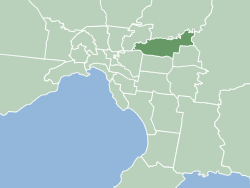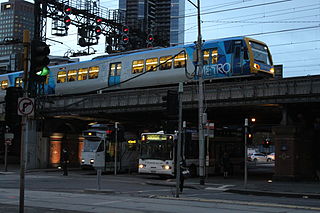
The City of Manningham is a local government area in Victoria, Australia in the north-eastern suburbs of Melbourne and is divided into 12 suburbs, with the largest being Doncaster and Doncaster East. It comprises an area of 113 square kilometres and had a population of 125,508 in June 2018.

EastLink is a tolled section of the M3 freeway linking a large area through the eastern and south-eastern suburbs of Melbourne, Australia.

Bulleen is an eastern suburb in Melbourne, Australia, 13 km north-east of the Melbourne central business district, located within the City of Manningham local government area. Bulleen recorded a population of 11,219 at the 2021 census.

Doncaster is a suburb of Melbourne, Victoria, Australia, 18 km north-east of Melbourne's Central Business District, located within the City of Manningham local government area. Doncaster recorded a population of 25,020 at the 2021 census.

Templestowe is a suburb of Melbourne, Victoria, Australia, 16 km north-east of Melbourne's Central Business District, located within the City of Manningham local government area. Templestowe recorded a population of 16,966 at the 2021 census.

Proposals for expansion of the Melbourne rail network are commonly presented by political parties, government agencies, industry organisations and public transport advocacy groups. The extensions proposed take a variety of forms: electrification of existing routes to incorporate them into the suburban rail system; reconstruction of former passenger rail lines along pre-existing easements; entirely new routes intended to serve new areas with heavy rail or provide alternative routes in congested areas; or track amplification along existing routes to provide segregation of services. Other proposals are for the construction of new or relocated stations on existing lines, to provide improved access to public transport services.

The Eastern Freeway is an urban freeway in eastern Melbourne, the state capital of Victoria, Australia. It is one of the most important freeways in terms of commuting to the city, connecting Alexandra Parade and Hoddle Street in the inner suburbs, with EastLink tollway farther east. It consists of between three and six lanes in each direction, also an inbound transit lane reserved for vehicles with two or more occupants during peak hours.

Transport in Melbourne, the state capital of Victoria, Australia, consists of several interlinking modes. Melbourne is a hub for intercity, intracity and regional travel. Road-based transport accounts for most trips across many parts of the city, facilitated by Australia's largest freeway network. Public transport, including the world's largest tram network, trains and buses, also forms a key part of the transport system. Other dominant modes include walking, cycling and commercial-passenger vehicle services such as taxis.

Westfield Doncaster is a shopping centre 50% owned by Scentre Group and 25% owned by ISPT and 25% owned by Asia Property Fund located in Doncaster, a suburb of Melbourne, Victoria, Australia. As of July 2014, the Westfield Group became two companies Scentre Group and Westfield Corporation. The Westfield Group portion is now owned by Scentre Group. It is located on the corner of Williamsons Road and Doncaster Road in the Doncaster Hill precinct, an ongoing planning initiative by the local Manningham council. It is located 20 minutes east of the CBD and is one of the biggest shopping centres in Victoria.

State (Bell/Springvale) Highway, also known as Bell Street/Springvale Road State Highway, is the longest self-contained urban highway in Melbourne, Australia, linking Tullamarine Freeway and Nepean Highway through Melbourne's north-eastern suburbs. These names are not widely known to most drivers, as the entire allocation is still best known as by the names of its constituent parts : Bell Street, Banksia Street, Manningham Road, Williamsons Road, Doncaster Road, Mitcham Road, Springvale Road and Edithvale Road. This article will deal with the entire length of the corridor for sake of completeness, as well to avoid confusion between declarations.
The East West Link is a proposed 18-kilometre tollway in Melbourne, Australia, to connect the Eastern Freeway at Clifton Hill with the Western Ring Road at Sunshine West. The Napthine Coalition Government signed a $5.3 billion contract with the East West Connect consortium in September 2014, just prior to the November 2014 state election, to begin construction on the eastern tunnel segment of the project. It became one of the central issues in the election, and a subsequent change in government led to the project's cancellation at a cost of $1.1 billion. The problem of poor "connectivity between Melbourne's Eastern Freeway and CityLink" has since been included in Infrastructure Australia's list of Australia's 32 "highest priority" infrastructure needs and various solutions remain part of long-term state road planning.

The 1969 Melbourne Transportation Plan was a road and rail transport plan for Melbourne, the state capital of Victoria, Australia, instituted by Henry Bolte's state government. Most prominently, the plan recommended the provision of an extensive freeway network, much of which has since been built.
The North East Link is an under construction 10–kilometre tolled motorway scheme in Melbourne, Australia. Its stated objective is to connect the Metropolitan Ring Road at Greensborough with the Eastern Freeway at Bulleen, where the freeway would be upgraded from Hoddle Street to Springvale Road at Nunawading.
The Eddington Transport Report was a major transport study undertaken in Victoria, Australia, by infrastructure consultant Sir Rod Eddington to propose improvements to transport links between the eastern and western suburbs of Melbourne. The report, titled "Investing in Transport–East West Link Needs Assessment", was commissioned in 2006 by the Government of Victoria following the model of the Eddington Transport Study in the United Kingdom and was released in April 2008. Eddington's report recommended new road and rail tunnels, further rail network electrification and improved cycle and bus routes in a bid to reduce congestion. Some of the report's recommendations were implemented by the Brumby Labor government, but many others remained unfunded.
Numerous proposals have been made for improvements to the Melbourne tram network, the largest such network in the world. Nearly all of these have been for track extensions of existing lines to connect with nearby railway station or to service new areas and suburbs.

Melbourne Airport Rail is a proposed rail link from the Melbourne CBD to Melbourne Airport at Tullamarine. Since October 2022, the project has also been considered as part of the Suburban Rail Loop (SRL) and branded as SRL Airport. The rail link will run through the under-construction Metro Tunnel, running 27 km from the airport to Town Hall station in the city centre with 12 km of new track between the airport and Sunshine station. The link will be a new branch of the Melbourne Metro rail network and run High-Capacity Metro Trains at a 10-minute frequency. The project is being delivered by the Victorian state government agency Rail Projects Victoria.
The Eastern Busway is bus rapid transit line under construction in the eastern suburbs of Melbourne, Australia. It would operate alongside the Eastern Freeway, from Hoddle Street in Abbotsford to Doncaster Road in Doncaster. As a part of the North East Link project and Eastern Freeway upgrade, the entire busway is expected to be commence construction in 2024 and be completed by 2028.

Doncaster Park and Ride is a park and ride bus station and future busway station located in Melbourne, Australia. It serves the suburb of Doncaster and situates next to the Eastern Freeway, and opened in January 2003. On some official sources and signage of the station, the "and" in its name is replaced by a "+" symbol, making it Doncaster Park + Ride.

Bulleen Park and Ride is a park and ride bus station and future busway station located in Melbourne, Australia serving the suburb of Bulleen and situated next to the Eastern Freeway. It was opened on 30 April 2023 by the Victorian government as the first piece of public infrastructure delivered by the North East Link project.















